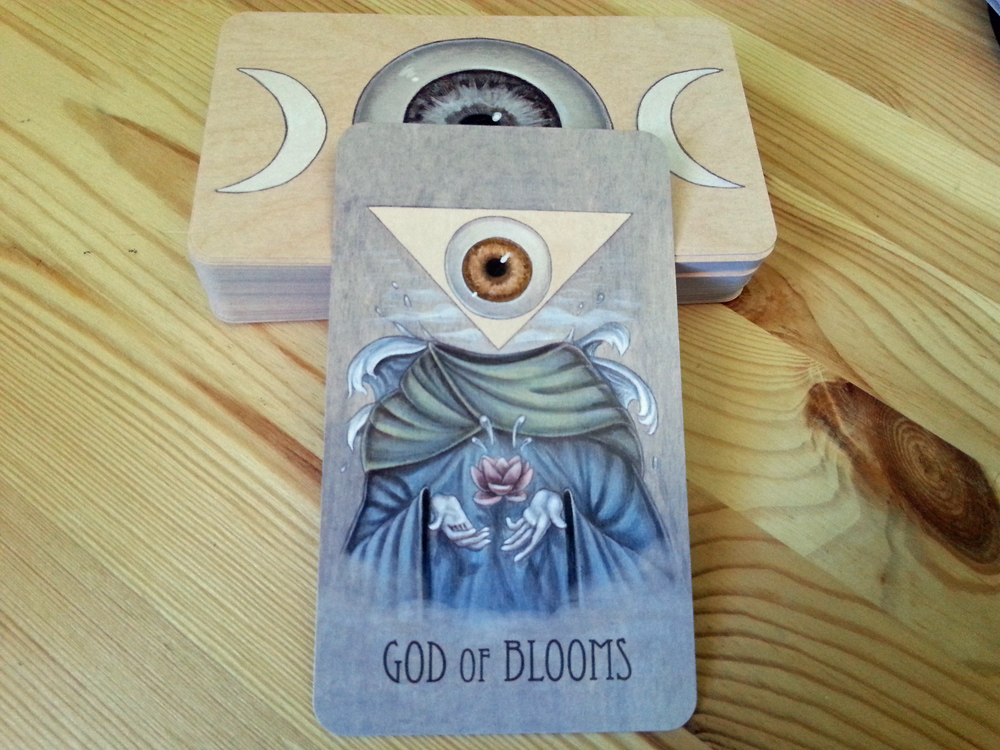This is part of an ongoing series in which I write about my interpretations of the cards in A.L. Swartz’s Wooden Tarot. You can find the other posts here.
The suit of Blooms in the Wooden Tarot corresponds to the suit of Cups/Chalices/Vessels, etc. in other decks. This means that Blooms are ruled by the element of water and preside over the realm of emotion and relationships.
I think blooms are a very fitting replacement for cups–they’re lush, watery, and beautiful. Human beings have long related flowers with emotions–either the emotions that the beauty of flowers gives rise to, or the expression of emotions through giving flowers. Compared with the suit of Bones, the suit of Blooms feels fertile and luxurious. But as you’d expect with the Wooden Tarot, this suit has a few twists: many of the blooms feature Swartz’s favorite visual: the eyeball. We’ll get to this further on down the line with the later cards in the suit. Another twist on the suit of Cups, which I’ve always found to be pretty gentle and introspective, is the court cards which all feature deadly, powerful, and/or aggressive sea animals: the Blue Angel nudibranch, the Swordfish, the Octopus, and the Betta Fish.
Like all of the cards in The Wooden Tarot, the Suit of Blooms takes what we think we know pretty well–our own emotions–and reflects them back to us in an inscrutable fashion. In this case, they literally stare back at us from the card and take the shape of some very non-humanoid creatures.
The God of Blooms

The God of Blooms wears a blue robe with a green mantle. Four cresting waves emerge from their shoulders and a pink lotus flower, from which four squirts of water emerge, hovers above their open, upturned hands. The God’s amber eye–directed slightly downward–peers out from the alchemical symbol for water: an inverted triangle.
Like the Ace of Cups in the Waite-Smith deck, in which a hand holds an overflowing cup in its open palm, the upturned palms of the God of Blooms suggests the receptive, rather than active, energy of the suit. Whether the God is giving or receiving is unclear, but their hand gesture nevertheless signals the openness and reciprocity of Blooms. As with the suit of Bones, the God’s eye is tilted slightly downward, again signaling receptivity, unlike the Gods of Stones and Plumes, who look slightly upward. The blue and green colors of their robes suggest not only water, but the affinity that water and earth have for each other. (I found a suggestion of Buddhist monks’ robes in the God of Bones, but the robes of the other three gods are a mystery to me. Please comment if you see something they represent.)
With the God of Blooms, things overflow. Unlike the dry, hard symbols that surround the God of Bones, this card signals that the Suit of Blooms is about things that ebb and flow. The waters of this suit are life-giving, but they are also volatile. With the God of Blooms, then, we may want to think of this suit as being about giving and receiving and being open to the present–of looking in a mirror and bearing witness to the strange fishiness of what we see.
A God of Blooms Reading
The Eye: What insight is waiting for me about the role of emotion in my life?
The Bloom: What do I need to be emotionally open to receiving?
Leave a Reply